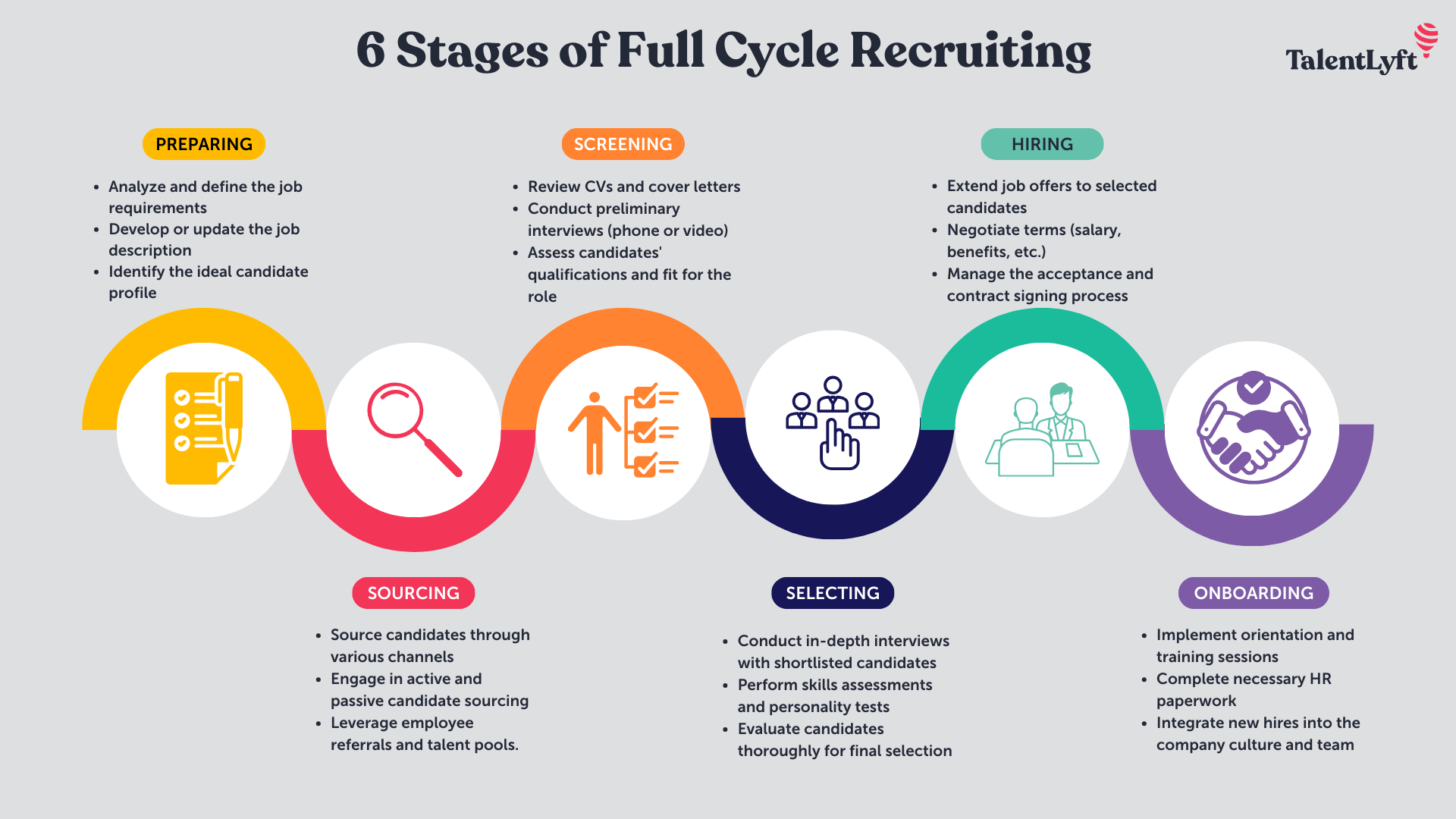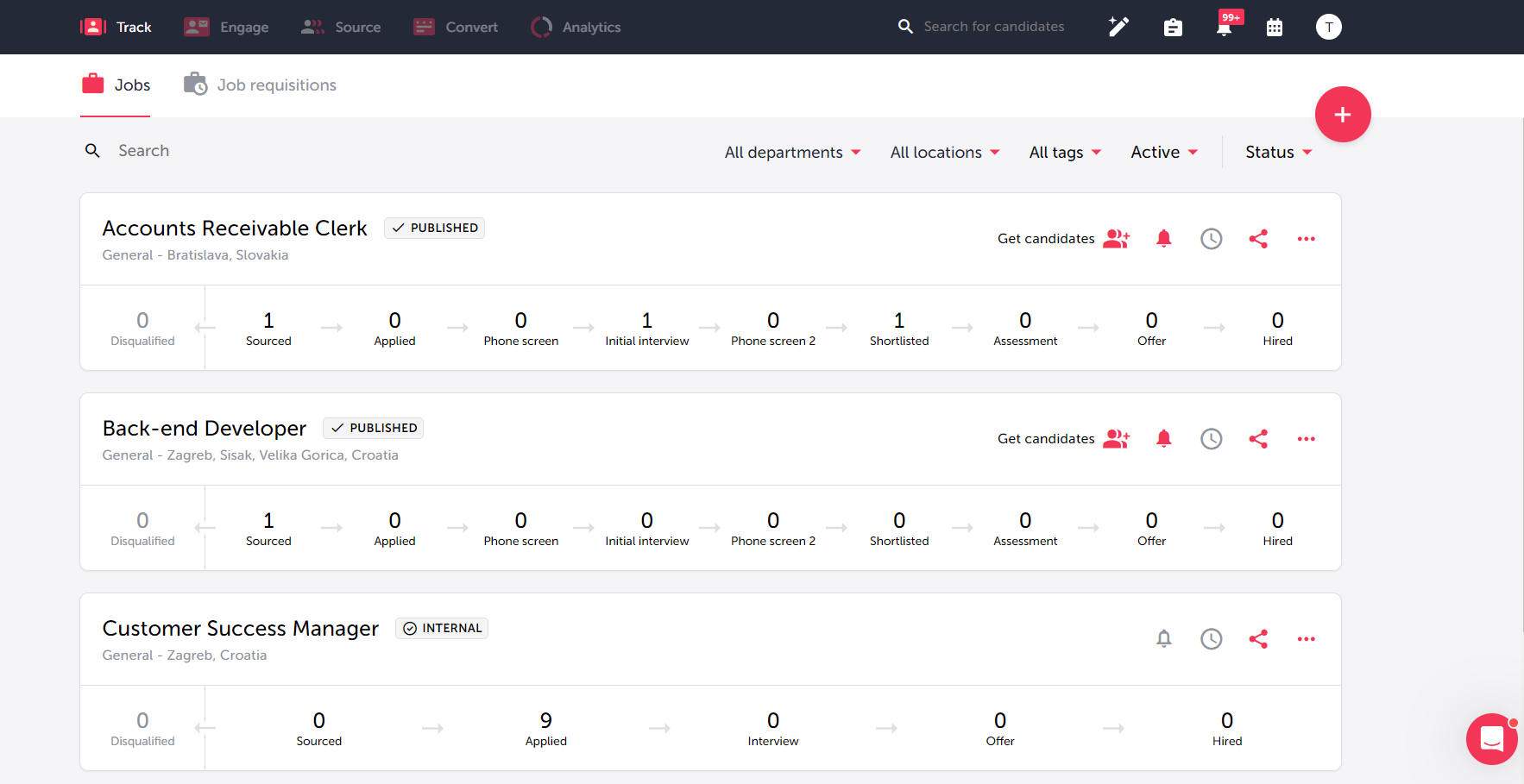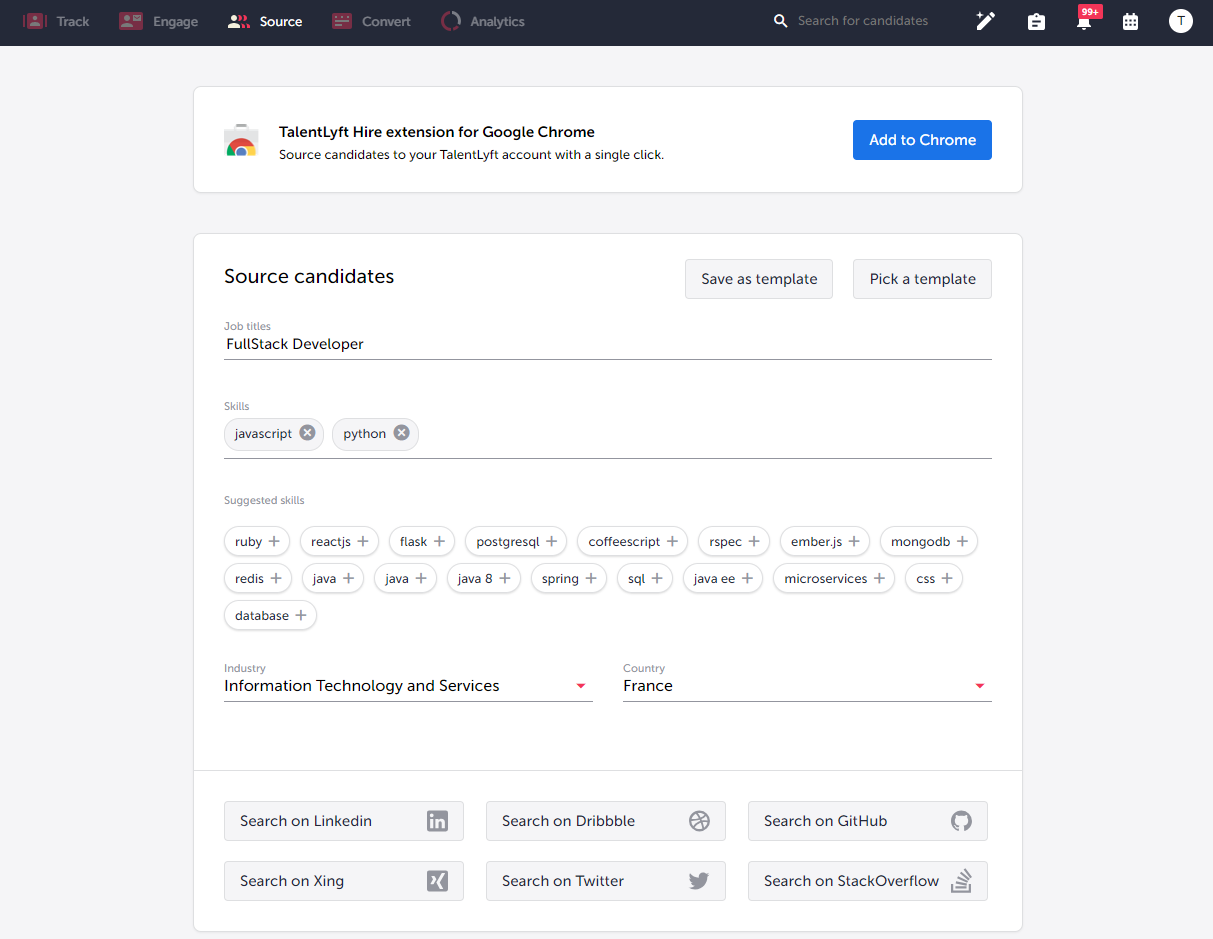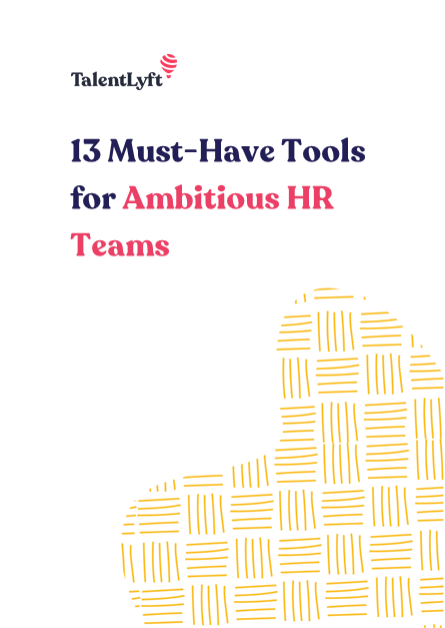![https://adoptoprod.blob.core.windows.net/article/RlKymcr9_0-IGfPe3a16xg.png?5084]()
What is full-cycle recruiting?
Full life cycle recruiting is a term used for a complete recruiting process, from start to finish. This is why it is also sometimes called an "End-to-end recruitment process" or simply, full-cycle recruiting.
Full life cycle recruiting encompasses different recruitment stages. The recruitment life cycle starts when a need for a new employee arises and ends with the onboarding of the new employee. Each of these stages will be explained in detail later in this text so you can fully understand what is full cycle recruiting.
Who is responsible for Full Cycle Recruiting?
To fully understand what is full-cycle recruiting before we dive deep into all the details, you must understand who holds the responsibility for the full-cycle recruiting and end-to-end recruitment process.
Responsibility for a full cycle recruiting process usually shifts with the company size:
In startups and smaller companies, there is usually one person responsible for the whole recruitment process. That person is called a Full Life Cycle Recruiter. A full-cycle recruiter is responsible for managing every step of the recruitment process. This includes preparing job descriptions, sourcing candidates, screening applications, conducting interviews, making job offers, and overseeing onboarding.
In medium-sized companies, there is usually an HR department with an HR team. Each person on the team usually specializes in performing certain stages of the recruiting process.
Large companies usually have extensive HR departments and Talent Acquisition teams where different members may specialize in various aspects of the process (like sourcing or interviewing), but they work together to ensure a seamless recruitment cycle.
The Process of Full Life Cycle Recruiting
We already mentioned that a full-cycle recruiting process incorporates a few different stages. So what are the main stages of a recruitment life cycle?
The full Life Cycle Recruiting process encompasses 6 main recruiting stages: preparing, sourcing, screening, selecting, hiring, and onboarding.

Each of the 6 main full-cycle recruiting stages encompasses different activities.
Stage 1: Preparing
“Before anything else, preparation is the key to success.” The first phase is all about preparation. A thorough job analysis lays the foundation for a successful recruitment process.
A need for a new team member has appeared and the hiring manager writes a job requisition and sends it out for approval. This triggers the start of the recruitment process and that is where it all starts.
To prepare for a winning full life cycle recruiting it is crucial to define your candidate persona and write a great job description.
Defining your candidate persona is the very first step of a successful recruiting strategy. A candidate persona is a semi-fictional representation of your ideal candidate. This persona is formed by defining the characteristics, skills, and personality traits that make up your perfect hire. Creating personas helps guide and make your end-to-end recruitment process easier.
Download FREE Guide: A Guide on Creating a Candidate Persona
The next step in this stage of a full cycle of recruiting is writing a job description that attracts candidates. Make sure to write a clear and accurate explanation of the job and responsibilities, not a laundry list of your requirements. Include information about the salary range, perks and benefits, and your company values. To help you save time, we have a database of over 500 job description templates and samples.
Stage 2: Sourcing
Professional recruiters use different methods for sourcing candidates. In today's world of high demand for talented workers, it is often not enough to just post job openings on job boards or career sites. This is because more than 70% of candidates are passive. That’s why modern recruiters turn to a more proactive approach to finding candidates.
First is web sourcing. With web sourcing, a single web search scans millions of online profiles to retrieve passive and active candidates’ details including email addresses, resumes, and more.
Second is social recruiting, using social media channels (such as Facebook, Twitter, LinkedIn, etc.) in recruiting.
Third is in-house recruiting or finding great candidates internally, among your existing employees.
Fourth are employee referral programs, structured programs that companies use to find talented people by asking their existing employees to recommend candidates from their existing networks.
Get our Guide for finding high-quality job candidates!
Stage 3: Screening
The goal of this full-cycle recruiting stage is to narrow down your applicants to the very best candidates.
The screening stage begins with reviewing employment applications, which usually consist of resumes, motivational letters, and/or portfolios. The goal of reviewing these documents is to find applicants whose qualifications, skills, and experiences best match your vacant job description.
These candidates then go into the next round of screening - a telephone informational interview. Candidates who make this cut are shortlisted and invited to a face-to-face interview.
Stage 4: Selecting
Selecting the very best candidate is the most critical part of the full-cycle recruiting process. No matter how good your potential candidates may seem on paper, seeing them in person is your ultimate opportunity to determine if they have the perfect combination of knowledge, skills, and experience you are looking for. Your requirements will vary depending on your industry and your vacant job position.
You can use a variety of candidate selection methods that best fit your hiring needs, like different types of auditions and testing (psychological tests, programming tasks, custom-written assignments, etc.).
The most common candidate selection method though is conducting interviews. To help you choose the right candidate, not just the best interviewer, we prepared this Complete guide to candidate interview questions.
Before making the final decision on the best candidate, this stage of full-cycle recruiting can on some occasions also include a background check of employees and/or their references.
Stage 5: Hiring
The hiring stage of the recruitment life cycle consists of two main activities: job offers and negotiations.
Once you find your perfect candidate, it’s time to notify him/her. According to the LinkedIn survey, 77% of candidates prefer receiving good news over the phone. Right after making that phone call, you should send an official job offer letter.
A well-structured job offer clarifies all hiring terms. It includes precise information on compensation and benefits, working hours and contract length, as well as the employment start date. To improve the chance of your job offer being accepted, it’s advisable to personalize it.
Sometimes a candidate won’t accept your job offer immediately, so further negotiations will be needed to reach a mutually satisfying employment contract. This is usually the most delicate recruiting stage of the whole end-to-end recruitment process. This is why it needs to be handled with special care and attention.
Stage 6: Onboarding
Despite popular belief, a recruitment life cycle doesn’t end when you hire a candidate. Onboarding is the final and perhaps the most crucial stage of the full cycle of recruiting. It can make or break your whole recruiting process! What is the point of finding and hiring those perfect candidates if you can’t make them stay and fit in your company culture?
Onboarding is not boring formal paperwork. Onboarding is all about making the new employees feel welcomed and helping them ease into their new workplace by teaming up with their new coworkers.
Great onboarding starts with introductions, then moves on to orientation, and ends up with training. Combining all these activities is the right formula for creating a winning onboarding which will guarantee a great start at your company for your new employee and the final success of your recruitment life cycle.
Full Life Cycle Recruiting tools
All these full-cycle recruiting stages seem complicated and very time-consuming. Well, that is the case if you are not using the right tools. There are many different tools that offer solutions for various recruitment life cycle stages and challenges. In addition, there are some recruiting and hiring tools that now offer all solutions in one tool. 💪
Our TalentLyft is an all-in-one recruiting platform that can help you organize and streamline your recruiting process. With TalentLyft you can manage, monitor, track, and measure your whole, end-to-end recruitment process from one place. Create jobs, source candidates from anywhere and engage with them, build your brand with a fully branded careers page and personalized communication campaigns and track everything through analytics.


Want to start practicing full life cycle recruiting?
Get in touch with our product specialists to learn more about our tool and help you personalize your full life cycle recruiting strategy!
Get your full life cycle recruiting strategy! Frequently asked questions
What is full life cycle recruiting?
Full life cycle recruiting encompasses the entire recruitment process from job requisition to onboarding, ensuring a comprehensive approach to hiring.
Who typically manages full-cycle recruiting?
The responsibility varies by company size: one person in small companies, specialized HR teams in medium-sized, and extensive HR and talent acquisition teams in large companies.
What are the main stages of full life cycle recruiting?
The six main stages are preparing (job analysis and description), sourcing (finding candidates), screening (narrowing down applicants), selecting (choosing the best candidate), hiring (job offers and negotiations), and onboarding (integrating new employees).
Why is onboarding considered part of the recruitment life cycle?
Onboarding ensures new hires are welcomed and effectively integrated into the company, crucial for the long-term success of the recruitment process.
How do recruiting tools benefit full life cycle recruiting?
Recruiting tools streamline the process, making each stage more efficient and allowing for better tracking, management, and measurement of recruitment activities.










![Boolean Search for Recruiters [Actionable Guide]](https://adoptoprod.blob.core.windows.net/article/7wyu_xAg806Tm_lmFg71Rw.png)








